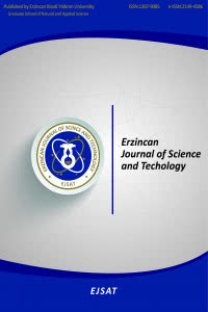Trombidioid (Acari: Parasitengona) Larva Derilerinin Değerlendirilmesi ve Teşhisteki Önemi
Acari, biyoloji, deri değiştirme, hayat evresi, Trombidioidea
Evaluation of Trombidioid (Acari: Parasitengona) Larval Exuviae And Its Importance In Diagnosis
___
- Gabryś, G. 1996. “Microtrombidiidae (Acari, Actinedida) of Poland. Annales of the Upper Silesian Museum”, Entomology, 6-7: 145-242.
- Gabryś, G., Felska, M., Kłosińska, A., Staręga, W. ve Mąkol, J. 2011. “Harvestmen (Opiliones) as hosts of Parasitengona (Acari: Actinotrichida, Prostigmata) larvae”, Journal of Arachnology, 39(2): 349-351.
- Kobulej, T. 1951. “Eine neue Trombidiiden Art, Trichotrombidium muscae gen et sp. n. (Microtrombidiinae Sig Thor, 1935)”, Acta veterinaria Academiae scientiarum hungaricae, 1 (1): 83-105.
- Mąkol, J. 2007. “Generic level review and phylogeny of Trombidiidae and Podothrombiidae (Acari: Actinotrichida:Trombidioidea) of the World”, Annales Zoologici, 57 (1): 1-194.
- Mąkol, J. ve Sevsay, S. 2011. “Notes on the genus Dolichothrombium (Acari: Prostigmata: Trombidiidae) with description of a new species”, Zootaxa, 2971: 1-16.
- Mąkol, J. ve Wohltmann, A. 2012. “An annotated checklist of terrestrial Parasitengona (Actinotrichida: Prostigmata) of the World, excluding Trombiculidae and Walchiidae”, Annales Zoologici, 62 (3): 359-562.
- Mąkol J, Wohltmann A. 2013. “Corrections and additions to, the checklist of terrestrial Parasitengona (Actinotrichida: Prostigmata) of the world, excluding Trombiculidae and Walchiidae”, Annales Zoologici. 63: 15–27.
- Mąkol, J., Gabryś, G. ve Łaydanowicz, J. 2011. “Leptus phalangii (De Geer, 1778) (Acari: Actinotrichida: Prostigmata) – redescription, ecology and taxonomic notes on its relatives”, Annales Zoologici, 61 (3): 535-546.DOI: 10.11158/saa.14.2.6
- Moniuszko, H., Felska, M., Mąkol, J. 2018 Evidence for co‑invasion events: different chigger species (Actinotrichida, Trombidioidea: trombiculidae) share a host”, Experimental and Applied Acarology, 76(1): 29-39.
- Robaux, P. 1974. “Recherches sur le developpement et la biologie des acariens ‘Thrombidiidae’. Memoires du Museum national d’histoire naturelle Paris (n.s.). Ser. A”, Zoologie, 85: 1-186.
- Seniczak, S. ve Seniczak, A. 2013. “Morphology of juvenile stages and ontogeny of three species of Damaeidae (Acari: Oribatida)”, International Journal of Acarology, 39(2), 160–179.
- Sevsay, S. 2017. “A checklist of the Erythraeoidea and Trombidioidea (Actinotrichida: Prostigmata) of Turkey”, Türkiye Entomoloji Bülteni, 7 (2): 175-196.
- Sevsay, S. ve Buğa, E. 2018. “Trombidiid (Acari: Trombidiidae) Akarlar tarafından parazitlenen konakçılar”, Erzincan Üniversitesi Fen Bilimleri Enstitüsü Dergisi, 11-3.
- Walter, D.E. ve Krantz, G.W. 2009. “Collecting, rearing, and preparing specimens. In: Krantz, G.W. & Walter, D.E. (eds.) A manual of Acarology. 3th edition”, Texas Tech University Press, pp. 83-96.
- Welbourn, W.C. 1985. “Phylogenetic studies of trombidioid mites dissertation”, PhD Thesis, The Ohio State University, 196.
- Wohltmann, A. ve Wendt, F. E. 1996. “Observations of the biology of two hygrobiotic trombidiid mites (Acari: Prostigmata: Parasitengona) with special regard to the recognition and parasitism tactics”, Acarologia, 37: 31-44.
- Wohltmann, A., Gabryś, G.ve Mąkol, J. 2006. “Terrestrial parasitengonain habiting transient biotopes, (In: R. Gerecke Ed.), Vol. 7/2-1, Chelicerata, Acari I. Spektrum Elsevier, München”, Süßwasserfaunavon Mitteleuropas, pp. 158-240.
- ISSN: 1307-9085
- Yayın Aralığı: 3
- Başlangıç: 2008
- Yayıncı: Erzincan Binali Yıldırım Üniversitesi, Fen Bilimleri Enstitüsü
Zaman-Kesirli Kadomtsev- Petviashvili Denkleminin Conformable Türev ile Yaklaşık Çözümleri
Hülya DURUR, Orkun TAŞBOZAN, Ali KURT, Mehmet ŞENOL
Lebesgue Uzayları Üzerinde Bileşke Operatörler
İlker ERYILMAZ, İbrahim DEĞİRMEN
Bigadiç Kolemanitin Tozaltı Kaynak Toz Bileşeni Olarak Kullanılabilirliği
Foto-kapan Görüntülerinde Hareketli Nesne Tespiti ve Konumunun Belirlenmesi
Emrah ŞİMŞEK, Özyer BARIŞ, Gülşah Tümüklü ÖZYER
2-triflorometil-4-nitroanilinin Spektroskopik ve Kuantum Mekaniksel Yöntemlerle Karakterizasyonu
Regresyon Analizinde Kullanılan Yanlı Tahmin Edicilerin Etkinliklerinin Karşılaştırılması
Sınav Çizelgeleme Problemi için Hedef Programlama Yaklaşımı ve Bir Uygulama
